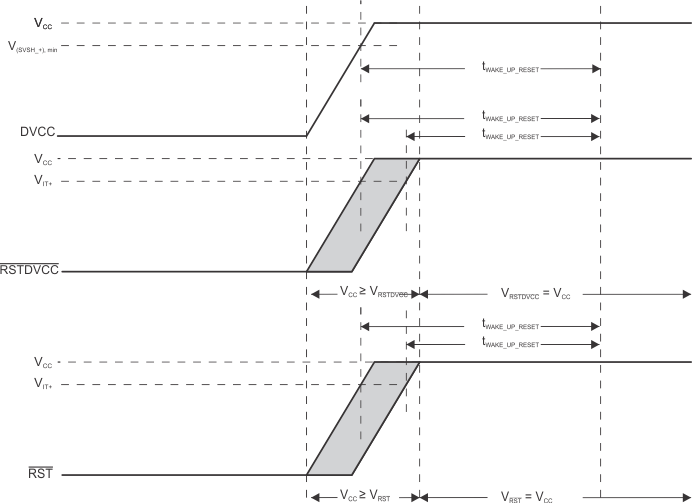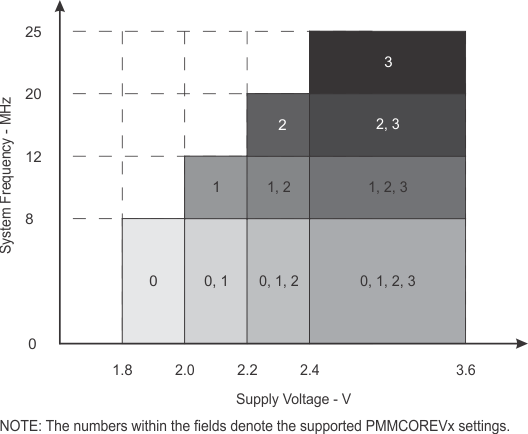JAJSG87B September 2013 – September 2018 MSP430F5232 , MSP430F5234 , MSP430F5237 , MSP430F5239 , MSP430F5242 , MSP430F5244 , MSP430F5247 , MSP430F5249
PRODUCTION DATA.
- 1デバイスの概要
- 2改訂履歴
- 3Device Comparison
- 4Terminal Configuration and Functions
-
5Specifications
- 5.1 Absolute Maximum Ratings
- 5.2 ESD Ratings
- 5.3 Recommended Operating Conditions
- 5.4 Active Mode Supply Current Into VCC Excluding External Current
- 5.5 Low-Power Mode Supply Currents (Into VCC) Excluding External Current
- 5.6 Thermal Resistance Characteristics
- 5.7 Schmitt-Trigger Inputs – General-Purpose I/O (P1.0 to P1.7, P2.0 to P2.7, P3.0 to P3.4, P4.0 to P4.7, P5.0 to P5.5, P6.0 to P6.7, P7.0 to P7.5, PJ.0 to PJ.3, RSTDVCC/SBWTDIO, RST/NMI)
- 5.8 Inputs – Interrupts (P1.0 to P1.7, P2.0 to P2.7)
- 5.9 Leakage Current – General-Purpose I/O (P1.0 to P1.7, P2.0 to P2.7, P3.0 to P3.4, P4.0 to P4.7, P5.0 to P5.5, P6.0 to P6.7, P7.0 to P7.5, PJ.0 to PJ.3)
- 5.10 Outputs – General-Purpose I/O (Full Drive Strength) (P1.0 to P1.7, P2.0 to P2.7, P3.0 to P3.4, P4.0 to P4.7, P5.0 to P5.5, P6.0 to P6.7, P7.0 to P7.5, PJ.0 to PJ.3)
- 5.11 Outputs – General-Purpose I/O (Reduced Drive Strength) (P1.0 to P1.7, P2.0 to P2.7, P3.0 to P3.4, P4.0 to P4.7, P5.0 to P5.5, P6.0 to P6.7, P7.0 to P7.5, PJ.0 to PJ.3)
- 5.12 Output Frequency – General-Purpose I/O (P1.0 to P1.7, P2.0 to P2.7, P3.0 to P3.4, P4.0 to P4.7, P5.0 to P5.5, P6.0 to P6.7, P7.0 to P7.5, PJ.0 to PJ.3)
- 5.13 Typical Characteristics – Outputs, Reduced Drive Strength (PxDS.y = 0)
- 5.14 Typical Characteristics – Outputs, Full Drive Strength (PxDS.y = 1)
- 5.15 Crystal Oscillator, XT1, Low-Frequency Mode
- 5.16 Crystal Oscillator, XT2
- 5.17 Internal Very-Low-Power Low-Frequency Oscillator (VLO)
- 5.18 Internal Reference, Low-Frequency Oscillator (REFO)
- 5.19 DCO Frequency
- 5.20 PMM, Brownout Reset (BOR)
- 5.21 PMM, Core Voltage
- 5.22 PMM, SVS High Side
- 5.23 PMM, SVM High Side
- 5.24 PMM, SVS Low Side
- 5.25 PMM, SVM Low Side
- 5.26 Wake-up Times From Low-Power Modes and Reset
- 5.27 Timer_A
- 5.28 Timer_B
- 5.29 USCI (UART Mode) Clock Frequency
- 5.30 USCI (UART Mode)
- 5.31 USCI (SPI Master Mode) Clock Frequency
- 5.32 USCI (SPI Master Mode)
- 5.33 USCI (SPI Slave Mode)
- 5.34 USCI (I2C Mode)
- 5.35 10-Bit ADC, Power Supply and Input Range Conditions
- 5.36 10-Bit ADC, Timing Parameters
- 5.37 10-Bit ADC, Linearity Parameters
- 5.38 REF, External Reference
- 5.39 REF, Built-In Reference
- 5.40 Comparator_B
- 5.41 Flash Memory
- 5.42 JTAG and Spy-Bi-Wire Interface
-
6Detailed Description
- 6.1 CPU (Link to User's Guide)
- 6.2 Operating Modes
- 6.3 Interrupt Vector Addresses
- 6.4 Memory Organization
- 6.5 Bootloader (BSL)
- 6.6 JTAG Operation
- 6.7 Flash Memory (Link to User's Guide)
- 6.8 RAM (Link to User's Guide)
- 6.9
Peripherals
- 6.9.1 Digital I/O (Link to User's Guide)
- 6.9.2 Port Mapping Controller (Link to User's Guide)
- 6.9.3 Oscillator and System Clock (Link to User's Guide)
- 6.9.4 Power-Management Module (PMM) (Link to User's Guide)
- 6.9.5 Hardware Multiplier (MPY) (Link to User's Guide)
- 6.9.6 Real-Time Clock (RTC_A) (Link to User's Guide)
- 6.9.7 Watchdog Timer (WDT_A) (Link to User's Guide)
- 6.9.8 System (SYS) Module (Link to User's Guide)
- 6.9.9 DMA Controller (Link to User's Guide)
- 6.9.10 Universal Serial Communication Interface (USCI) (Links to User's Guide: UART Mode, SPI Mode, I2C Mode)
- 6.9.11 TA0 (Link to User's Guide)
- 6.9.12 TA1 (Link to User's Guide)
- 6.9.13 TA2 (Link to User's Guide)
- 6.9.14 TB0 (Link to User's Guide)
- 6.9.15 Comparator_B (Link to User's Guide)
- 6.9.16 ADC10_A (Link to User's Guide)
- 6.9.17 CRC16 (Link to User's Guide)
- 6.9.18 Reference (REF) Module Voltage Reference (Link to User's Guide)
- 6.9.19 Embedded Emulation Module (EEM) (S Version) (Link to User's Guide)
- 6.9.20 Peripheral File Map
- 6.10
Input/Output Diagrams
- 6.10.1 Port P1 (P1.0 to P1.7) Input/Output With Schmitt Trigger
- 6.10.2 Port P2 (P2.0 to P2.7) Input/Output With Schmitt Trigger
- 6.10.3 Port P3 (P3.0 to P3.4) Input/Output With Schmitt Trigger
- 6.10.4 Port P4 (P4.0 to P4.7) Input/Output With Schmitt Trigger
- 6.10.5 Port P5 (P5.0 and P5.1) Input/Output With Schmitt Trigger
- 6.10.6 Port P5 (P5.2 and P5.3) Input/Output With Schmitt Trigger
- 6.10.7 Port P5 (P5.4 and P5.5) Input/Output With Schmitt Trigger
- 6.10.8 Port P6 (P6.0 to P6.7) Input/Output With Schmitt Trigger
- 6.10.9 Port P7 (P7.0 to P7.5) Input/Output With Schmitt Trigger
- 6.10.10 Port J (PJ.0) JTAG Pin TDO, Input/Output With Schmitt Trigger or Output
- 6.10.11 Port J (PJ.1 to PJ.3) JTAG Pins TMS, TCK, TDI/TCLK, Input/Output With Schmitt Trigger or Output
- 6.11 Device Descriptors
- 7デバイスおよびドキュメントのサポート
- 8メカニカル、パッケージ、および注文情報
パッケージ・オプション
メカニカル・データ(パッケージ|ピン)
- RGZ|48
サーマルパッド・メカニカル・データ
- RGZ|48
発注情報
5.3 Recommended Operating Conditions
| MIN | NOM | MAX | UNIT | |||
|---|---|---|---|---|---|---|
| VCC | Supply voltage during program execution and flash programming (AVCC = DVCC)(1)(3) | PMMCOREVx = 0 | 1.8 | 3.6 | V | |
| PMMCOREVx = 0, 1 | 2.0 | 3.6 | ||||
| PMMCOREVx = 0, 1, 2 | 2.2 | 3.6 | ||||
| PMMCOREVx = 0, 1, 2, 3 | 2.4 | 3.6 | ||||
| VSS | Supply voltage (AVSS = DVSS) | 0 | V | |||
| TA | Operating free-air temperature | –40 | 85 | °C | ||
| TJ | Operating junction temperature | –40 | 85 | °C | ||
| CVCORE | Recommended capacitor at VCORE(2) | 470 | nF | |||
| CDVCC/ CVCORE | Capacitor ratio of DVCC to VCORE | 10 | ||||
| fSYSTEM | Processor frequency (maximum MCLK frequency)(4) (see Figure 5-2) | PMMCOREVx = 0 (default condition),
1.8 V ≤ VCC ≤ 3.6 V |
0 | 8.0 | MHz | |
| PMMCOREVx = 1,
2.0 V ≤ VCC ≤ 3.6 V |
0 | 12.0 | ||||
| PMMCOREVx = 2,
2.2 V ≤ VCC ≤ 3.6 V |
0 | 20.0 | ||||
| PMMCOREVx = 3,
2.4 V ≤ VCC ≤ 3.6 V |
0 | 25.0 | ||||
(1) TI recommends powering AVCC and DVCC from the same source. A maximum difference of 0.3 V between AVCC and DVCC can be tolerated during power up and operation.
(2) A capacitor tolerance of ±20% or better is required.
(3) The minimum supply voltage is defined by the supervisor SVS levels when it is enabled. See the threshold parameters in Section 5.22 for the exact values and further details.
(4) Modules may have a different maximum input clock specification. See the specification of the respective module in this data sheet.

NOTE:
The device remains in reset based on the conditions of the RSTDVCC/SBWTDIO and RST pins, along with the voltage present on DVCC voltage supply. Holding RSTDVCC/SBWTDIO or RST at a logic low or holding DVCC below the SVSH_+ minimum threshold causes the device to remain in its reset condition; that is, these conditions form a logical OR with respect to device reset. Figure 5-2 Maximum System Frequency
Figure 5-2 Maximum System Frequency